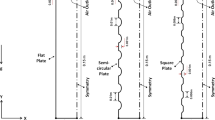Abstract
Thermal management system which can reject very high amount of heat by small thermal devices will be required for future space systems. Our purpose is to develop miniaturized heat rejection system that can reject more than 100 W/cm2. In the evaporator, thin liquid film vaporization which can dissipate very high heat flux, was utilized. The liquid film is stabilized in micro-channels by capillary forces. The microchannels are fabricated by chemical etching on silicon and copper plate. Also miniaturized condenser which utilized droplet condensation was tested. Droplets were produced on a cooled plate covered by non-wetting coating. After we built a heat rejection system constructed by above mentioned evaporator and condenser, influence of heat flux, coolant flow rate, and inlet temperature on the temperature of the heater element were investigated. Water is used as working fluid. Heat flux of 100 W/cm2 could be achieved for water inlet temperature in flow rate of 3.0 mL/min. The temperature of the heater element is kept constant at about 120°C.
Similar content being viewed by others
References
Krotiuk W. J., 1990, “Thermal-Hydraulics for Space Power, Propulsion, and Thermal Management System Design”. Vol. 122, Progress in Astronautics and Aeronautics.
Stephan P. C. andBusse C. A., 1992, “Analysis of the Heat Transfer Coefficient of Grooved Heat Pipe Evaporator Walls”. Int. J. Heat and Mass Transfer 35,383–391.
Xu X. andCarey V. P., Film, 1990, “Evaporation from a Micro-Grooved Surface — An Approximate Heat Transfer Model and Its Comparison with Experimental Data”. Journal of Thermophysics 4 (4) 512–520.
Author information
Authors and Affiliations
Additional information
Paper was presented on the Second International Topical Team Workshop on TWO-PHASE SYSTEMS FOR GROUND AND SPACE APPLICATIONS October 26–28, 2007, Kyoto, Japan.
Rights and permissions
About this article
Cite this article
Imai, R., Tsukamoto, T. Basic study on heat rejection system using high heat flux micro channel evaporator. Microgravity Sci. Technol 19, 30–32 (2007). https://doi.org/10.1007/BF02915742
Received:
Revised:
Accepted:
Issue Date:
DOI: https://doi.org/10.1007/BF02915742




